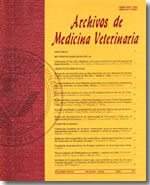Use of biomarkers for the diagnosis of joint disease in horses
Main Article Content
Abstract
Lameness associated to joint disease (JD) in athlete equines is an important cause of economic losses. Intensive training produces biomechanical overload of the synovial joints with a consequent activation of metalloproteinases, which have been associated to the pathogenesis of equine JD. This disease is characterized by the degradation of the extracellular matrix (ECM) of the articular cartilage causing the release of structural components of the cartilage matrix to the joint space and producing changes in the synovial fluid concentration of these ECM components, termed biomarkers. The changes in the concentration of some of these proteins in the synovial fluid might be used to evaluate both the onset and progression of equine JD. The measurement of the levels of aggrecan and collagen type II in the synovial fluid using specific monoclonal antibodies is an example of this approach. This review presents an update on biomarkers used for equine JD.

